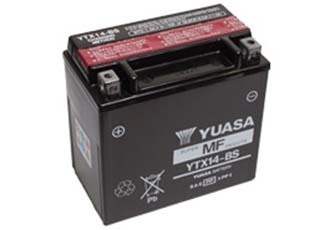The ST1100 battery is located under the left side cover. In order to access it, the pannier, seat, and side cover need to be removed.
The OEM item supplied with the motorcycle is a Yuasa YTX14-BS. Its specifications are as follows:
- 12 volt
- 12Ah capacity
- 200A Cold crank current (EN)
- Dimensions (mm):
150(h) x 87(d) x 145(w) - Terminal layout: Left: positive Right: negative (With the terminals on the edge furthest from the motorcycle)
A higher performance ST1100 battery is also available. This is the Yuasa YTX14H-BS. The only difference is that this type offers 240A Cold crank current (EN) - but at nearly double the price of the standard type I'm not sure the price is worth it.
There are four main types of lead-acid battery:
- Dry Filled Batteries
- Also known as FLA (Flooded Lead Acid), these are supplied empty and need to be filled with the supplied acid to the upper fill level. They should then be left to settle for ten minutes, the acid levels checked again, and then charged. The cell caps should only be installed once the battery has been charged. It is important to ensure that the acid level is at the upper fill mark before and after charging.
- Gel Filled Batteries (The Yuasa is one of these)
- Also supplied empty, the foil seal needs to be removed from the battery, and the plastic cap from the acid cartridge. Press the cartridge on to the top of the battery, piercing the seals, and allow it to drain completely before removing it and pressing the plastic sealing strip firmly on to the top of the battery. The acid changes to gel within a few hours.
- Absorbed Glass Mat (AGM) VRLA (Valve Regulated Lead Acid)
- A sealed battery which provides high starting performance and deep cycling capability. Requires no action before charging.
- Sealed-For-Life Batteries
- These batteries are supplied ready-filled, and being fully sealed they require no action before charging. This type of battery should not be opened for any reason.
Obviously when filling a battery, suitable precautions should be taken - it is acid you're working with!
Charging:
Prior to installation, new batteries should be charged on a trickle charge at a rate of approximately 1.4A per hour for 6 hours. A car battery charger should not be used unless the output current can be selected.
(By the way, the ST1100 alternator will only start charging the battery once the rpm exceeds 2000.)
If you are thinking about replacing your ST1100 battery, you may wish to read the following first...
Having been away on holiday for two weeks, I discovered the battery was completely flat when I returned. Thinking that it had outlived its useful life, I decided to replace it.
I was horrified to discover the prices of the OEM Yuasa, so instead decided to try and source an equivalent.
I found a dry-filled type online at approximately 20% of the cost of a Yuasa. The dimensions were similar in width and depth, but slightly higher at 165mm - not a problem, I thought - I'm sure it will fit. Bad move. It didn't.
I then found another make - Motorcycle Energy Squadron - at approximately 40% of the cost of a Yuasa. This time I looked at the dimensions carefully.
Width - 130mm. Check.
Depth - 85mm. Check.
Height - 140mm. Check.
Excellent. So I purchased that one. Bad move number 2. The terminals were the wrong way around - positive on the right and negative on the left.
I went for a short walk.
It suddenly occurred to me that whilst waiting for the replacement battery/batteries to arrive, I had been using the bike daily, and it had started fine each morning - so the battery was actually all right. It just hadn't liked being abandoned for two weeks.
So I decided to get an Optimate
Oh - and in case you were wondering - I keep the two "cheaply expensive" batteries charged, and use them in the workshop whenever I need a 12V power source!
Update, 2021: After 14 years the Yuasa finally started losing charge, so I purchased a replacement. A genuine one this time; like this:

